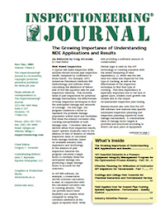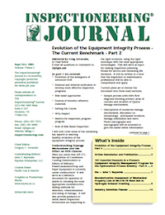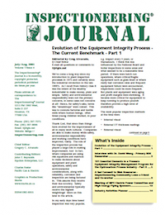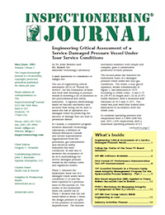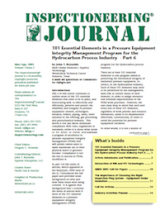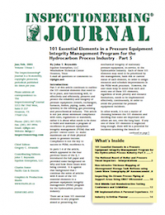Effective Planning for Utilization of Contractor API Inspectors
The Growing Importance of Understanding NDE Applications and Results
Engineering Critical Assessment of a Service-Damaged Pressure Vessel Under Sour Service Conditions
Risk Based Inspection (RBI) Applied to Power Boilers - Successful Case in Brunei
Interaction of RBI and FFS Technologies
The Importance of Choosing the Right Inspection Plug System - Equipment Under Insulation
2001 Inspectioneering Journal Article Index
Part 5 of this article continues to outline the 101 essential elements that need to be in place, and functioning well, to effectively and efficiently, preserve and protect the reliability and integrity of pressure equipment (vessels, exchangers,...
The use of contractor inspectors for turnarounds has increased in recent years. Mergers with reductions in staff personnel for major oil and chemical companies have fueled this growth. Still, we hear "horror" stories about problems that occur during...
The use of engineering critical assessment (ECA)of "fitness for service", for the evaluation of flaws and local wall thinning in pressure vessels is receiving a lot of attention in the petrochemical and utility industries. A rigorous methodology...
We've come a long way since my introduction to plant inspection processes in 1975 and certainly since the industrial revolution in the late 1800's. As I recall from history class it was the intent of the wealthy industrialist to make money, plain...
Are you truly prepared for your next Turnaround? Effective work processes are required to successfully plan, manage, review and supervise plant turnarounds. Inspection planning and work scope selection are critical aspects of any turnaround...
In part 1 we covered: - Evolution of the emergence of advanced NDE - External and internal motivators to develop more effective inspection programs - Risk based approaches - Sources of industry reference materials - Setting the Course - Why...
In a previous edition of IJ, we alerted readers to a proposal to the Texas PE Board that would require NDT inspector certification according to CP-189 (instead of SNT-TC-1A), which would effectively eliminate limited-scope certifications.
This article describes a new inspection technology for rapid, on-stream,quantitative examinations of piping under support areas. This portable production system has been in commercial operation in the major U.S. Gulf Coast refineries for the past...
With the publication of API RP 579 For Fitness-For-Service and the planned publication of API RP 580 for Risk Based Inspection in 2001, these technologies will find increasing application in maintenance and inspection planning.
Inspectioneering caught up with Dave Wang at the American Petroleum Institute’s (API) Spring 2001 Refining meeting in Atlanta, Georgia. We spent some time, near the pool at a break between meetings, discussing Dave’s background, experiences...
The objective of this joint industry project is to develop and commercialize a non-intrusive system for mapping the thickness of aboveground storage tank (AST) bottoms using Lamb wave tomography.
Hydrogen-induced cracking is a damage mechanism commonly observed in the petroleum refining industry [1, 2]. The damage appears as laminar cracks and blisters, which can link up in the through-wall direction to form stepwise cracking.
This is a summary about RBI application to plant utility boilers in a liquefied natural gas plant with a design life of 20 years, now 27 years old.
A typical risk based inspection (RBI) analysis should include past inspection results, tempered by confidence in those results. For example, API's (American Petroleum Institute) RBI methodology and software when calculating the likelihood of failure...
Determination of the mechanical integrity of pipe and equipment in US process industries has evolved from day to day business to federal mandate (OSHA 1901.119) to a part of industry best practice. Insulated pipe and equipment pose specific...
